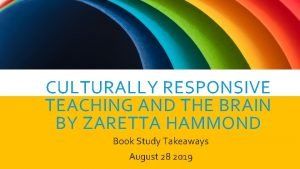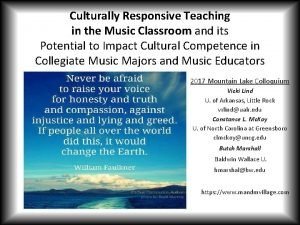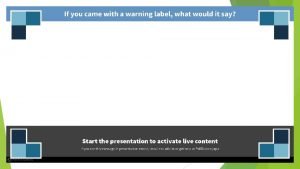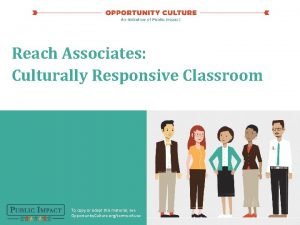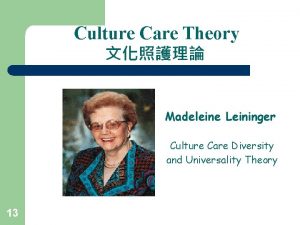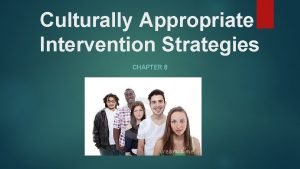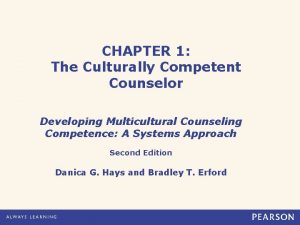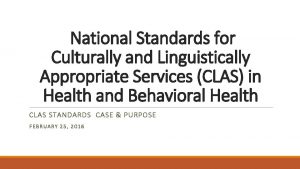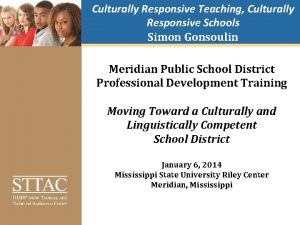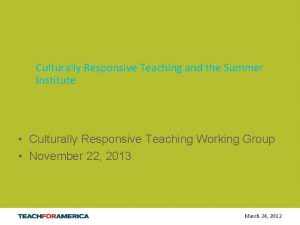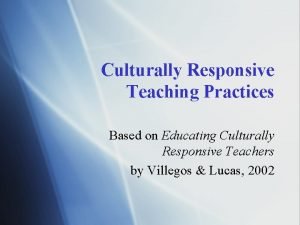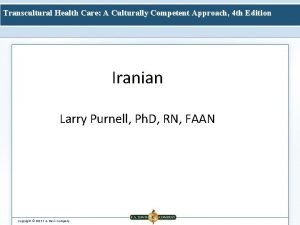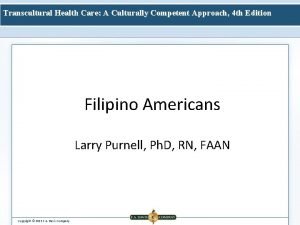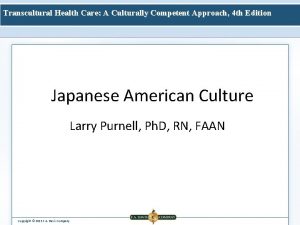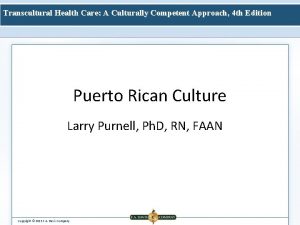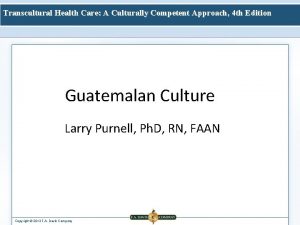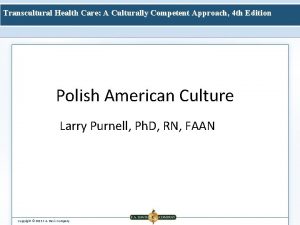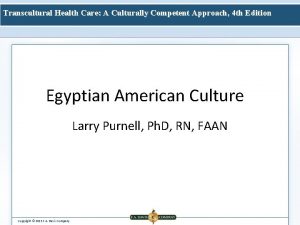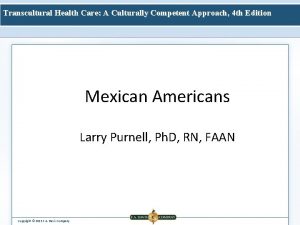Transcultural Nursing Culturally Responsive Nursing Care Chapter 18




















- Slides: 20

Transcultural Nursing Culturally Responsive Nursing Care Chapter 18

Culturally Responsive Care • Centered on the client’s cultural perspectives • Integrates the client’s values and beliefs • Nurse must develop self-awareness of: • own culture, attitudes, and beliefs • biases and assumptions he/she holds about different cultures • Gain knowledge/skill

Cultural Concepts • • Culture Subculture Diversity Race Ethnicity Nationality Religion

Cultural Concepts (cont'd) • • • Ethnocentrism Prejudice Racism Discrimination Generalizations Stereotyping

Immigration • Acculturation • Assimilation

Health Beliefs and Practices • • Magico-religious health belief Scientific or biomedical health belief Holistic health belief Folk medicine

Magico-religious health belief • • Health and illness are controlled by supernatural forces Illness resulted from “being bad” or opposing God’s will Getting well is also dependent on God’s will Evil spirit, magic, or spell can cause illness

Scientific (Biomedical) Health View • Life is controlled by physical and biomechanical processes manipulated by humans • Illness is caused by germs, bacteria, or a breakdown of the body • Pills, treatments, or surgery will cure

Holistic Health Belief • Forces of nature must be maintained in balance or harmony • Human life is one aspect of nature • Illness results from an imbalance or disharmony

Figure 18 -2 A medicine wheel in Arizona. Holden, Roger/Photolibrary. com

Folk Medicine • • Beliefs and practices derive from cultural traditions Thought to be more humanistic than biomedical health care May be less expensive Less frightening

Coining Therapy

Family Patterns • • • Decision maker Value of children and elders Gender role behavior Family involvement Naming systems

Verbal Communication • Initiating communication influenced by cultural values • Use of interpreter

Nonverbal Communication Behaviors • Meaning to the client • Meaning in the client’s culture • • • Silence Touch Facial expressions Eye movement Body posture

Other Aspects of Culture • Space orientation • Time orientation • Nutritional patterns • Religious practices

Nursing Management • Developing self-awareness • Conveying cultural sensitivity • Assessment

Planning & Implementing • Cultural preservation and maintenance • Cultural accommodation and negotiation

Evaluating • Client’s cultural perspectives • Actual clients outcomes compared with the goals and expected outcomes • If not achieved, must carefully consider whether the client’s belief system has been adequately included as an influencing factor

QUESTIONS? ? ?
 Culturally responsive vs culturally relevant
Culturally responsive vs culturally relevant Vdoe culturally responsive teaching
Vdoe culturally responsive teaching Culturally responsive teaching and the brain slides
Culturally responsive teaching and the brain slides Culturally responsive teaching in music education
Culturally responsive teaching in music education Classroom
Classroom Reach associates
Reach associates Certified transcultural nurse
Certified transcultural nurse Madeleine leininger theory
Madeleine leininger theory Transcultural health care
Transcultural health care Transcultural health care definition
Transcultural health care definition Sunrise model madeleine leininger
Sunrise model madeleine leininger Transcultural nursing questions
Transcultural nursing questions Patricia enciso
Patricia enciso Transcultural interprofessional practice model
Transcultural interprofessional practice model Tertiary level of care
Tertiary level of care Culturally deprived meaning
Culturally deprived meaning Culturally appropriate intervention strategies
Culturally appropriate intervention strategies Culturally competent counselor
Culturally competent counselor Working with culturally and linguistically diverse families
Working with culturally and linguistically diverse families Culturally relevant pedagogy
Culturally relevant pedagogy National culturally and linguistically appropriate services
National culturally and linguistically appropriate services


